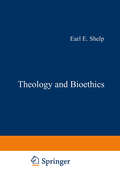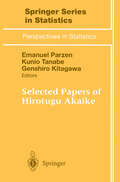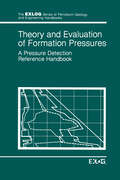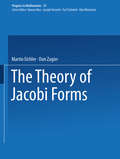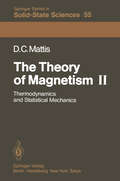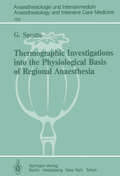- Table View
- List View
Theology and Bioethics: Exploring the Foundations and Frontiers (Philosophy and Medicine #20)
by Earl E. ShelpWe who live in this post-modern late twentieth century culture are still children of dualism. For a variety of rather complex reasons we continue to split apart and treat as radical opposites body and spirit, medicine and religion, sacred and secular, private and public, love and justice, men and women. Though this is still our strong tendency, we are beginning to discover both the futility and the harm of such dualistic splitting. Peoples of many ancient cultures might smile at the belatedness of our discovery concerning the commonalities of medicine and religion. A cur sory glance back at ancient Egypt, Samaria, Babylonia, Persia, Greece, and Rome would disclose a common thread - the close union of religion and medicine. Both were centrally concerned with healing, health, and wholeness. The person was understood as a unity of body, mind, and spirit. The priest and the physician frequently were combined in the same individual. One of the important contributions of this significant volume of essays is the sustained attack upon dualism. From a variety of vantage points, virtually all of the authors unmask the varied manifestations of dualism in religion and medicine, urging a more holistic approach. Since the editor has provided an excellent summary of each article, I shall not attempt to comment on specific contributions. Rather , I wish to highlight three 1 broad themes which I find notable for theological ethics.
Theoretical Approaches to Turbulence (Applied Mathematical Sciences #58)
by D. L. Dwoyer M. Y. Hussaini R. G. VoigtTheoretical Aspects of Band Structures and Electronic Properties of Pseudo-One-Dimensional Solids (Physics and Chemistry of Materials with B #4)
by Hitomi KimuraThis volume presents a sequence of articles which describe the theoretical treat ments of investigating the fundamental features in the electronic structures and properties of typical quasi-one-dimensional solids; organic conductor TTF-TCNQ, polyacetylene, metallic and superconducting polymer (SN)n and linear chain chal cogenides and halides of transition elements including NbSe3' The aim of this volume is not to present an exhaustive review but rather to touch on a selective class of problems which appear to be fundamental for typical quasi-one-dimensional solids. Thus the topics in this volume are rather confined to the key basic properties of quasi-one-dimensional systems. The quasi-one-dimensional solids are one of the most extensively investigated subjects in current physics, chemistry and materials science. These materials are unique in attracting a broad range of scientists, chemists, experimental and theore tical physicists, materials scientists and engineers. In 1954 Frohlich constructed a theory of superconductivity based on a one-dimensional model of moving charge density waves. In 1955 Peierls predicted that anyone-dimensional metal is unstable against the distortion of a periodic lattice so that a metal-nonmetal transition occurs at a certain temperature for a one-dimensional metal. According to these theories a gap is opened at the Fermi surfaces of one-dimensional conductors at low tempera tures and the charge density wave is created in connection with the occurrence of the gap.
Theories, Models, And Simulations In International Relations: Essays And Research In Honor Of Harold Guetzkow
by Michael D WardBorn in 1915, Harold Guetzkow might have been a child of the "Roaring Twenties." But in fact Professor Guetzkow is much more a "child of the depression" (to use his own term). A complication of essays by scholars who took time and energy to pen their work in honor of Harold Guetzkow. The chapters that follow represent a real contribution to the study of international relations and document the influence of Harold Guetzkow in catalyzing that study over the last thirty years.
Theory and Applications of Drilling Fluid Hydraulics (Exlog Series of Petroleum Geology and Engineering Handbooks #1)
by EXLOG/WhittakerThe objectives of this book are (1) to serve as a reasonably comprehensive text on the subject of drilling hydraulics and (2) to provide the field geologist with a quick reference to drilling hydraulics calculations. Chapter 1 introduces the basic principles of fluid properties, and Chapter 2 presents the general principles of fluid hydraulics. Chapters 3 through 10 analyze specific hydraulic considerations of the drilling process, such as viscometric measurements, pressure losses, swab and surge pressures, cuttings transport and hydraulic optimization. References are presented at the end of each section. The units and nomenclature are consistent throughout the manual. Equations are given generally in consistent S.1. units; some common expressions are also given in oilfield units. Nomenclature is explained after every equation when necessary, and a comprehensive list of the nomenclature used is given in Appendix A. Units are listed in Appendix B. In Appendix C, all the important equations are given in both S.1. and oilfield units. Appendix D contains example hydraulics calculations. A glossary is included. THEORY AND APPLICATION OF DRILLING FLUID HYDRAULICS 1 INTRODUCTION To dri 11 a we 11 safely and succes sfull y depends upon a thorough unders tandi ng of drilling hydraulics principles. Thus, drilling hydraulics is a very impor tant subject with which all logging geologists should be familiar.
Theory and Evaluation of Formation Pressures: A Pressure Detection Reference Handbook (Environment, Development and Public Policy: Public Policy and Social Services)
by EXLOG/WhittakerThe objectives of this book are: (1) to educate the prospective Pressure Evaluation Geologist to a basic level of expertise; (2) to provide a reference tool for the experienced geologist; and (3) to foster constructuve thought and continued development of the field geologist. Despite the incorporation of many new ideas and concepts, elaboration of the more re cent concepts is limited due to space considerations. It is hoped that the geologist will follow up via the literature referenced at the end of each chapter. Easy reference is provided by the detailed table of contents and index. A glossary of terms, definitions, and formulae adds to the usefulness of this reference text. ACKNOWLEDGMENTS FOR FIGURES Figure 2-7 is reprinted by permission of the AAPG from Barker, 1972. Figure 4-21 is courtesy of Totco Figure 5-2 is reprinted by permission of the Oil and GasJournal from Matthews and Kelly, 1967. Figure 5-4 is reprinted by permission of the SPE-AIME from the Journal of Petroleum Technology from Eaton, © 1969. Figure 5-5 is reprinted by permission of the SPE-AIME from Hubbert and Willis, © 1957.
Theory and Practice of Robots and Manipulators: Proceedings of RoManSy '84: The Fifth CISM — IFToMM Symposium
by A. Morecki G. Bianchi K. K?dziorThe RO MAN SY Symposia have played an important role in the development of the theory and, to a lesser extent, the practice of manipulators, walking machines and robots. Based on past experience of previous symposia, which have been held over the last 10 years, the problem arose as to what to do in the future. In other words, in what direction should further symposia be organized? A panel discussion called 'Role of RO MAN SY Symposia' was held on 29 June 1984 during the final plenary session at CISM, Udine, Italy. The Members of the Organizing Committee, Professors Konstantinov, Morecki, Roth, Vukobratovic and Vertut, and other participants were asked to give their opinions on the follow ing important questions: • should we organize future symposia? if we continue, which form should we choose?: small (60-70 participants, • 35-40 invited papers); big (100-150 participants, 60-80 papers) • what kind of topics should be included?: the more theoretical-oriented; more practical-oriented; both (what proportion?) • how frequently should RO MAN SY Symposia be organized?: every other year; every third year is working well and what should be maintained? • what • what is not working well and what should be changed to increase the impact of the symposia? would like to underline that most of the participants agree that we should con tinue to hold our symposia every other year, but to limit their small form, with invited papers at high theoretical level only in mechanics, control of motion,
A Theory of Action Identification (Basic Studies in Human Behavior Series)
by Robin R. Vallacher Daniel M. WegnerFirst published in 1985. Routledge is an imprint of Taylor & Francis, an informa company.
A Theory of Action Identification (Basic Studies in Human Behavior Series)
by Robin R. Vallacher Daniel M. WegnerFirst published in 1985. Routledge is an imprint of Taylor & Francis, an informa company.
A Theory of Cognitive Aging (ISSN #Volume 28)
by T. SalthouseOver a half-century of research has documented the fact that people of different ages perform at different levels on a variety of tests of cognitive functioning, and yet there are still no comprehensive theories to account for these phenomena. A Theory of Cognitive Aging is intended to begin intellectual discussion in this area by identifying major issues of controversy, and proposing a particular theoretical interpretation based on the notion that the rate of processing information slows down with increased age. Although still quite preliminary, the theoretical perspective is demonstrated to provide a plausible account for age-related differences in functioning on measures of memory, spatial ability and reasoning. The book has four aims: - To advocate a more explicitly theoretical approach to research in the area of cognitive aging. - To outline three important dimensions along which it is argued that any theory of cognitive aging phenomena must take a position. - To evaluate empirical evidence relevant to specific positions along those dimensions. - To summarize the major concepts of the current theory, and to describe its application to selected findings in the research literature.
A Theory of Cross-Spaces. (AM-26), Volume 26 (PDF)
by Robert SchattenThe description for this book, A Theory of Cross-Spaces. (AM-26), Volume 26, will be forthcoming.
Theory of Heavy Fermions and Valence Fluctuations: Proceedings of the Eighth Taniguchi Symposium, Shima Kanko, Japan, April 10–13, 1985 (Springer Series in Solid-State Sciences #62)
by Tadao Kasuya Tetsuro SasoThe Theory of Magnetism II: Thermodynamics and Statistical Mechanics (Springer Series in Solid-State Sciences #55)
by Daniel C. MattisWhat is thermodynamics? What does statistical physics teach us? In the pages of this slim book, we confront the answers. The reader will discover that where thermodynami cs provi des a 1 arge scal e, macroscopi c theory of the ef fects of temperature on physical systems, statistical mechanics provides the microscopic analysis of these effects which, invariably, are the results of thermal disorder. A number of systems in nature undergo dramatic changes in aspect and in their properties when subjected to changes in ambient temperature or pres sure, or when electric or magnetic fields are applied. The ancients already knew that a liquid, a solid, or a gas can represent different states of the same matter. But what is meant by "state"? It is here that the systematic study of magnetic materials has provided one of the best ways of examining this question, which is one of the principal concerns of statistical physics (alias "statistical mechanics") and of modern thermodynamics.
Thermal Conductivity 18
by T. Ashworth David R. SmithThe International Thermal Conductivity Conference was started in 1961 with the initiative of Mr. Charles F. Lucks, who passed away on 8 July 1982 and to the memory of whom this volume is dedicated. These Conferences on thermal conductivity grew out of the needs of researchers in the field. The Conferences were held annu ally from 1961 to 1973 and have been held biennially since 1975 when our Center for Information and Numerical Data Analysis and Synthesis (CINDAS) of Purdue University became the Permanent Sponsor of the Conferences. These Conferences provide a broadly based forum for researchers actively working on the thermal conduc tivity and closely related properties to convene on a regular basis to exchange their ideas and experiences and report their findings and results. The Conferences have been self-perpetuating and are an example of how a technical community with a common purpose can transcend the invisible, artificial barriers between disciplines and gather together in increasing numbers without the need of national pub licity and continuing funding support, when they see something worthwhile going on. It is believed that this series of Conferences not only will grow stronger, but will set an example for research ers in other fields on how to jointly attack their own problem areas.
Thermo-Mechanical Solar Power Plants: Proceedings of the Second International Workshop on the Design, Construction and Operation of Solar Central Receiver Projects, Varese, Italy, 4–8 June, 1984 (Solar Energy R&D in the Ec Series B: #2)
by J. Gretz A. S. Strub A. SkinroodIn this book, the Commission of the European Communities presents the proceedings of the Workshop on Solar Central Receiver Projects, held in Varese, I taly , in June 1984. This Workshop was supported by all operators of solar tower power plants around the world and, as a result, these proceedings provide a comprehensive overview of the technology in its current state of development. The Workshop was organized by the Commission of the European Communities in the frame of the second solar energy R&D programme under the responsibility of its Di rectorate-General (X 11) for Science, Research and Development in Brussels. The meeting place, Varese, in Italy, was selected because of its neighbourhood to the Ispra Establishment of the Commission's Joint Research Centre who cooperated in the organization of the Workshop. Solar power plants of the central receiving type have two conflicting characteristics: they employ very simple and classical components but as a system they are of tremendous complexity. It was the hope for rapid progress by using available components that guided the decisions taken in the late seventies to build six large experimental plants: four in Europe, one in Japan and one in the United States. At that time, this technology enjoyed high priority in solar energy R&D around the world. Once the plants were completed, however, it became clear that the technical complexity combined with difficult meteorological conditions at most construction sites made the yields less favourable than anticipated.
Thermographic Investigations into the Physiological Basis of Regional Anaesthesia (Anaesthesiologie und Intensivmedizin Anaesthesiology and Intensive Care Medicine #159)
by G. SprotteThinking About Nuclear Weapons: Analyses and Prescriptions
by Fred Holroyd`It is really encouraging to see that such a book has been published ... No one can deny that Open University students - and all other interested parties - are given both sides of case.' - Tribune
Thinking About Nuclear Weapons: Analyses and Prescriptions
by Fred Holroyd`It is really encouraging to see that such a book has been published ... No one can deny that Open University students - and all other interested parties - are given both sides of case.' - Tribune
Thinking and Learning Skills: Volume 2: Research and Open Questions (Psychology of Education and Instruction Series)
by Susan F. Chipman and Judith W. Segal and Robert Glaser"First Published in 1985, Routledge is an imprint of Taylor & Francis, an informa company."
Thinking and Learning Skills: Volume 2: Research and Open Questions (Psychology of Education and Instruction Series)
by S. F. Chipman J. W. Segal R. Glaser"First Published in 1985, Routledge is an imprint of Taylor & Francis, an informa company."
Thinking and Learning Skills: Volume 1: Relating Instruction To Research (Psychology of Education and Instruction Series)
by J. W. Segal S. F. Chipman R. GlaserFirst Published in 1985. Routledge is an imprint of Taylor & Francis, an informa company.
Thinking and Learning Skills: Volume 1: Relating Instruction To Research (Psychology of Education and Instruction Series)
by Judith W. Segal, Susan F. Chipman and Robert GlaserFirst Published in 1985. Routledge is an imprint of Taylor & Francis, an informa company.
Thiophene and Its Derivatives, Part 1 (Chemistry of Heterocyclic Compounds: A Series Of Monographs #146)
by Salo GronowitzThe Chemistry of Heterocyclic Compounds, since its inception, has been recognized as a cornerstone of heterocyclic chemistry. Each volume attempts to discuss all aspects – properties, synthesis, reactions, physiological and industrial significance – of a specific ring system. To keep the series up-to-date, supplementary volumes covering the recent literature on each individual ring system have been published. Many ring systems (such as pyridines and oxazoles) are treated in distinct books, each consisting of separate volumes or parts dealing with different individual topics. With all authors are recognized authorities, the Chemistry of Heterocyclic Chemistry is considered worldwide as the indispensable resource for organic, bioorganic, and medicinal chemists.
